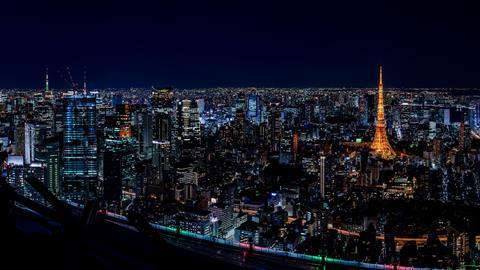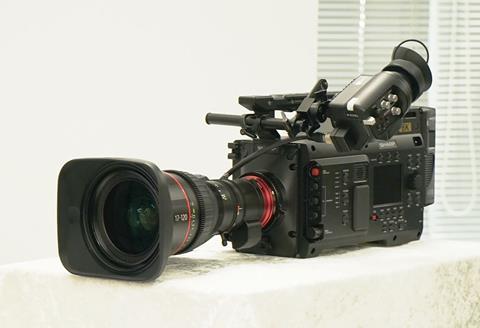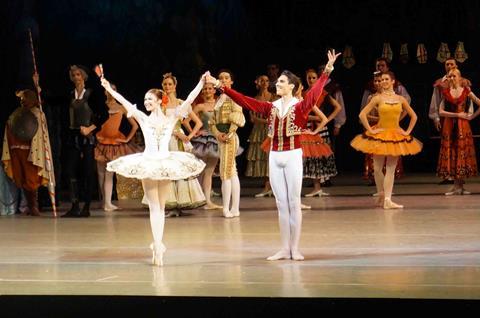Manufacturers have been showcasing their latest 8K displays and the upcoming Winter Games looks set to be a watershed for 8K production, but what does the long term future hold for high resolution content?

CES was awash with 4K Ultra HD displays, and in addition a few brave pioneers were showcasing their 8K models.
Sony offered up a 10,000 nit 85-inch high dynamic range Bravia 8K demo model which reportedly made some observers squint, such was its brilliance. Of course, Sony likes to proudly claim its skill in supplying the complete ‘glass to glass’ camera-to-screen production process – and with movies and TV shows - helping Sony with every aspect of the technology chain.
But there were more than a few grumblers at CES, arguing that who would want such floor-busting 8K beasts when there’s no content to show?
The fact is that some in the production community are preparing for a number of 8K events in this year’s transmission calendar.
The imminent Winter Olympics in PyeongChang are being captured in 8K by KBS (Korean Broadcasting System) and Japanese public broadcaster NHK which promises 8 hours of 8K test transmissions per day. Sony, Ikegami and Astro cameras will be involved in the trials. NHK says it will also cover the Winter Paralympics for the first time with live 8K transmissions. The live broadcasts from PyeongChang will begin on 9 March (until 18 March).
Certain 8K programming will also be aired live on NHK’s BS1 satellite channel. NHK says that some of the Paralympic competitions will also be captured in 8K. NHK says it will film mainly Japanese competitors at the Games with 8K cameras, and broadcast highlights of the Paralympics for test broadcast for its 8K, Super Hi-Vision, broadcasts.
It is undeniable that the number of 8K sets in Japanese homes this March will be just a few above zero. The transmissions are largely for testing production and workflow methods, and the ease of getting these signals back to Tokyo and as ‘proof of concept’ as far as NHK’s Tokyo-based 8K production facilities are concerned.

As for TV displays there are choices.
Indeed, 8K displays have been prototyped for years. LG showcased a unit at CES in 2016 while Sharp used IFA in Berlin in 2017 to announce its 8K unit (a snip at $73,000). Samsung is promising an 8K unit by the end of this year.
At CES 2018 there were choices in 8K between LCD, QLED and OLED, and to be perfectly fair all looked quite stunning. But there was especially high praise for Sharp’s large (70-inch) and small (27-inch) options. And if anyone doubts that there could be a market for small 8K displays they only have to look at NHK’s prototype 10-inch tablet, in 8K, to see spectacular detail.

Most of these display manufacturers are stressing the upscale benefits of their 8K kit, and the end-results available from upscaled 4K material.
There are others with much the same claim to image capture excellence, not least the highly-praised Red cluster of cameras as well as camera units from Panasonic and Sharp.
Indeed, Sharp, now under the ownership of the fabulously wealthy Foxconn Technology Group, is ramping up its 8K credentials. At CES it showed its 8K ecosystem starting with a broadcast-targeted camcorder (8C-B60A) that shoots 7680x4320 pixels at 10-bit depth and very much addressing large format production demand from the US, Japan and China.
But back to content – or the claimed ‘lack of’.
Executives from Japanese public broadcaster NHK told delegates at the MIPCOM UHD event in Cannes in October 2017 that it was making a variety of programming in 8K ‘Super Hi-Vision’ as well as increasing its investment in 4K UHD content.
Senior producer/Global content development, Yukari Hayashi told delegates that on 1 December 2018 NHK will launch the world’s first 8K channel to complement the 4K channel over Japan.
“Our 4K channel will screen 18 hours of content a day and the 8K channel and 12 hours and 10 minutes of content a day. That’s a major commitment, so we need to create many different kinds of 8K/4K programming to be ready for this massive task.
“8K and 4K each has its own respective and 4K’s advantages combine high-resolution with mobility, so it is well-suited for live coverage of sports events for example, while 8K technology allows us to create a new type of astonishing ultra-high high-definition, wide-angle content.”
NHK used MIPCOM to showcase a 60-minute factual documentary on the Yellowstone National Park in 8K.
The show includes aerial shots of a pack of wolves in quite spectacular footage with a clarity of detail that ‘ordinary’ TV cannot match. Senior producer Jun Ochiai also highlighted a project ‘Tokyo by Night’ captured in 8K and High Dynamic Range, as well as a 90-minute ballet at the famous Mariinsky Theatre which was filmed with 22.2 channel sound.

“The ballet’s producer was amazed at the final result, saying a theatre-goer could never see this sort of detail even if sat in the best seat in the house!”
In April (at MIPtv, April 9-12) NHK will unveil its latest prestigious 8K output.
It includes ‘Techne’ where six famous Japanese artists each exploit 8K. More conventionally, NHK will show how their 30-year run of classical music broadcasts are now increasingly being captured in 8K, including Wagner’s Lohengrin featuring drone shots of Neuschwanstein Castle.
A Japanese rock group, Sacanaction, has been filmed in 8K (10 x 8K cameras, 6 x 4K cameras and 22.2 channel audio). But Japan’s rich cultural heritage is not being ignored, and as well as traditional theatre they have also captured Emperor Hirohito’s Royal Palace Treasures in 8K.
Will 8K take off on a global scale? Given that more than half the planet is still viewing in standard definition, it is unlikely to happen any time soon.
But one of these days when the 4K market is mature, and profit margins are again squeezed, the likes of Sony, LG, Samsung, Panasonic and Sharp, as well as Hisense, Skyworth and the other Chinese set-builders will want the ‘next big thing’, and are readying for 8K to fill that demand.
The one valid anxiety for wider adoption of 8K is the bandwidth required for transmission. But a potential solution is in sight in the shape of H.266, a new compression standard now under development with the first test versions due this coming October. By October 2019 the first version of the standard is promised and June 2021 the first hardware encoders/decoders should be ready.
The target is a 50% saving over HEVC. That might just provide the catalyst for 8K.
FVC/H.266 Development Schedule
- Standardisation process has started
- Target >50% over HEVC
- Oct 2017, Call for Proposals
- Feb 2018, Responses evaluation
- Oct 2018, First test models due
- Oct 2019, First versions of Standard
- End 2020, Final Standard
- June 2021, First hardware Codecs
Data: Ateme
























No comments yet